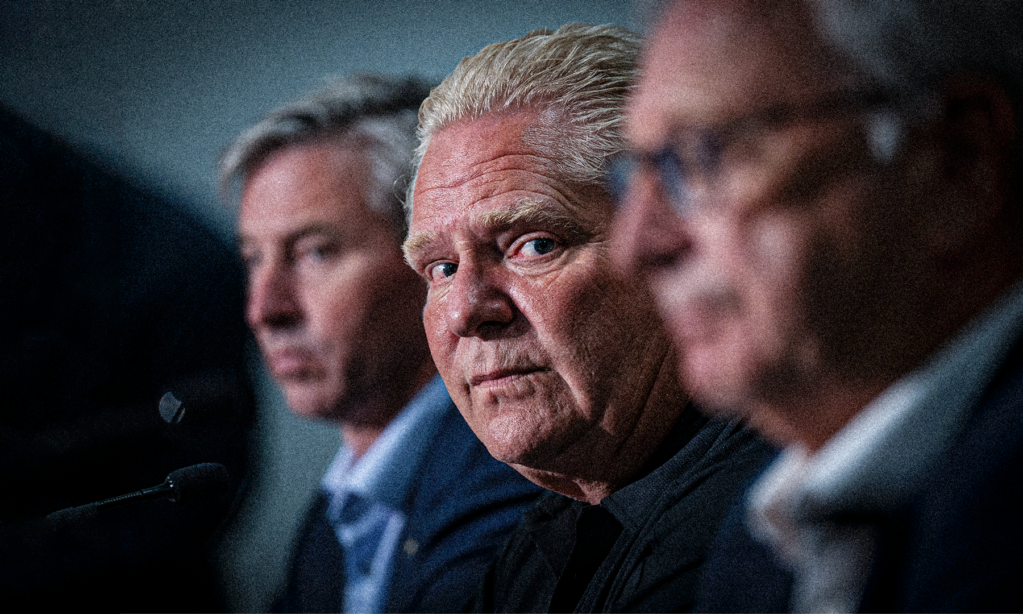Ontario Premier Doug Ford went to the Maritimes this week, but he didn’t come home with the $10 billion for health care he’s been seeking.
The point of the trip was, apparently, to discuss solutions to the current health care crisis with the premiers of New Brunswick, Nova Scotia, and Prince Edward Island. But Ford’s real purpose in heading east may have been to visit Dominic Leblanc, federal minister of intergovernmental affairs.
The premiers want a massive expansion of the Canada Health Transfer, and they have to go through Leblanc to get it. Ford and Leblanc met for a chat on Monday.
Like all premiers, Ford insists that the federal government is shortchanging the provinces through the Canada Health Transfer (CHT), which they say should be increased by a whopping $28 billion a year, no strings attached. For Ontario, that would mean a boost of roughly $10 billion a year.
The premiers’ rationale is that in the 1950s and 1960s the federal government agreed to pay half the cost of hospitals and doctors if the provinces would create single-payer health care, i.e., medicare, to deliver those services. Currently, the premiers say, the CHT covers just 22% of health care costs. In a spirit of compromise, however, they are willing to settle for the feds covering just 35% of those costs.
Now, in 2022, the provinces want more money, and more autonomy, but without the political cost that could come with raising provincial taxes.
The history of health care funding in Canada is complex to the point of comedy, but, for those interested, the brief but thorough explanation by Haizhen Mou at the University of Saskatchewan is worth reading. For the current conversation, two facts stand out as fundamental: first, health care now means much more than hospitals and doctors and includes other services like mental health, home care, and long-term care; and second, the premiers’ calculations do not include the value of tax points transferred from the federal government to the provinces in the past, when Ottawa reduced its personal and corporate income tax rates explicitly so the provinces could increase theirs.
The transfer of tax points gave the provinces more autonomy, as they were spending money they had raised themselves. Now, in 2022, the provinces want more money, and more autonomy, but without the political cost that could come with raising provincial taxes.
In July, Minister Leblanc said the federal government was ready to spend more on health care but not without conditions, and he singled out the Ford government’s pre-election rebates of licence plate sticker fees as a particular reason why.
“We’re not going to increase the federal spending to provinces for health care so they can then reduce their own spending,” Leblanc said. “That would be absurd. They say they need more money, well, if we’re going to increase the federal spending, at a minimum we would expect that they maintain and increase their own spending at the rate that they expect us to. We would also expect that that money not be used to run up huge surpluses, as many of them did with federal monies during COVID, or to send cheques to people on the eve of an election.”
Ouch!
For the record, the table below shows all of the ways in which the Ford government has reduced its own revenues through a variety of tax cuts, tax credits, and fee cuts since 2018. The total revenue reduction in the current fiscal year, 2022-23, is at least $7.5 billion. This does not include $1.8 billion for the licence fee rebates; these were a one-time expense in the 2021-22 fiscal year and simply added to the provincial debt.
The table does not distinguish between good decisions and bad ones. Reducing taxes on low-income Ontarians is good (although not as good as raising the minimum wage); giving away money in an untargeted fashion—by cutting licence fees, for example—is not. Either way, all of the measures listed here have one thing in common: they reduce the revenues needed to pay for health care and other priorities.
If the premier wants to make the case for more federal health funding, throwing away money is not the way to do it.







